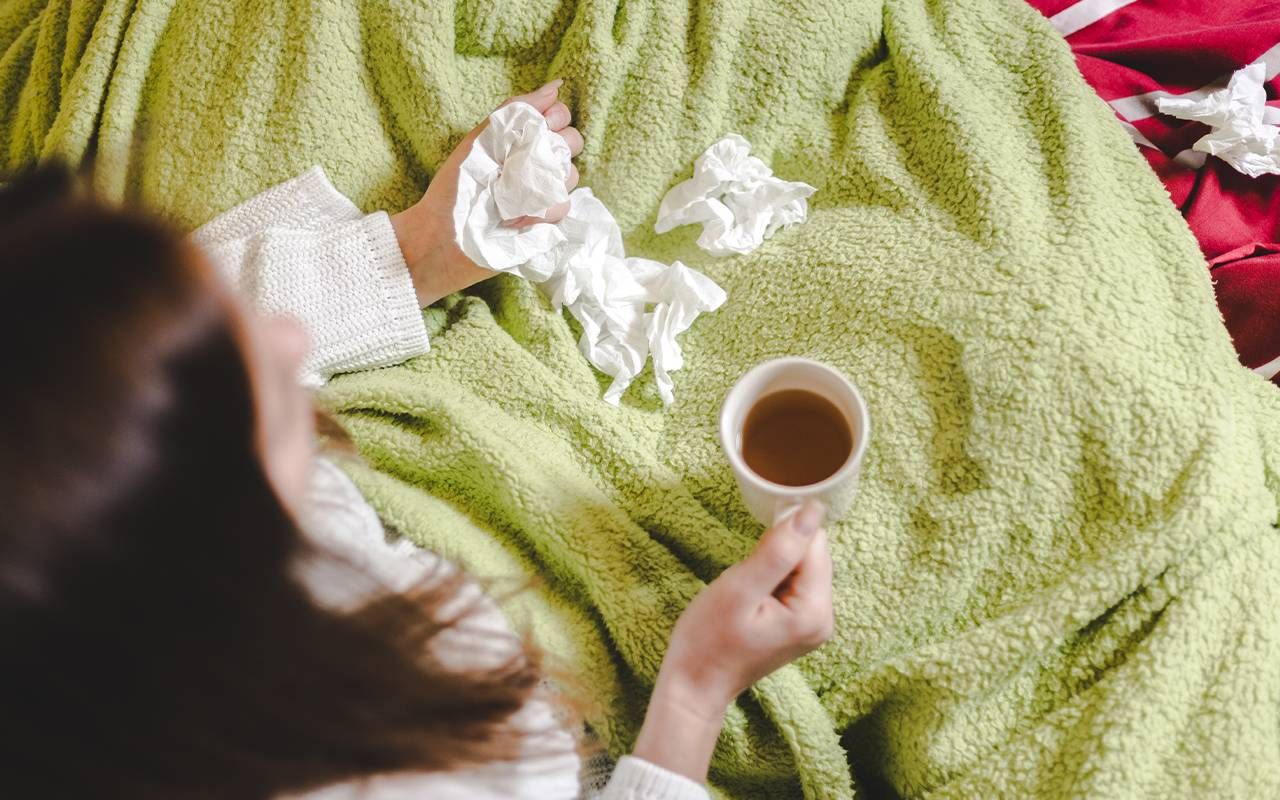Tissues Everywhere: Managing a Runny Nose
Also known as nonallergic rhinitis, here are some tips on how to slow the flow
My 82-year-old mother is forever looking for tissues these days to care for what appears to be a constant runny nose. Recently, I noticed she was armed with Kleenex, whether in her hand, rolled up in a sleeve, or attached to a nostril. "I have no idea why my nose is running away from me," she quipped on a recent walk around a park.

While Mom is in her early 80s, several 60-year-old friends have begun experiencing this phenomenon. I have suffered from nasal sensitivities due to environmental factors since childhood — these women had no known allergies. And yet, seemingly out of thin air, each became uncomfortable leaving their homes without nose protection.
Flashbacks of both my grandmothers walking around in their housecoats, crumpled tissues in each pocket, always ready to catch a drop. Could this be another sign of aging?
I began to wonder what the commonality was, and then it hit me; flashbacks of both my grandmothers walking around in their housecoats, crumpled tissues in each pocket, always ready to catch a drop. Could this be another sign of aging?
I think it's safe to say people recognize many body parts soften with age. I had not considered that our noses do as well. It turns out that the structure of the nose changes over time. Specifically, the elasticity of nasal tissue weakens, resulting in less support and contributing to various symptoms ranging from too much mucous to the opposite in nasal congestion.
This condition is so popular it has numerous names; here are just three: nonallergic rhinitis (NAR), vasomotor rhinitis, and geriatric rhinitis. For this article, we'll use NAR, which affects 17-19 million people in the United States, 70% of women aged 50-64. Hardly geriatric!
Nonallergic Rhinitis Explained
Our noses have ample jobs for such little attention. Manan Shah, ENT, allergist, and co-founder of Wyndly, said, "the nose as designed takes in air, dust and particles; and nose hairs and mucous filter things out." He further explained that when the inside of our nose becomes irritated, it can make too much mucous, otherwise known as rhinorrhea (a thin, runny fluid).
In the case of NAR, however, there is no specific trigger; Shah and other experts suggest it could be an autonomic response between the brain and nervous system.
"The composition of our nasal tissues, specifically the lining or mucosa of the nose, changes around the age of 60. These changes include thinning of the mucosa, general decrease in the water content of the mucus, degeneration of the mucous secreting glands, and decrease in nasal blood flow," according to Marianella Paz-Lansberg, MD, Assistant Professor of Otolaryngology-Head and Neck Surgery, Boston University Chobanian and Avedisian School of Medicine.
"The most common manifestation we see patients present is a chronic clear discharge from the nose," she said. However, other symptoms may include pressure or discomfort in the sinuses. Shah added that with individuals staying active and exercising later in life, rhinitis also increases in older patients, which means inflammation and swelling in nasal tissues.
It turns out that the structure of the nose changes over time.
NAR often arrives with a runny or stuffy nose, mucous in your throat, sneezing or coughing. With such commonplace signs, it can be easy for NAR to mimic something more serious.
"Geriatric rhinitis can actually be confused with many other nasal issues," Paz-Lansberg said. Such diagnoses could be vasomotor rhinitis, chronic sinusitis, or an anatomical problem that needs to be fixed with either medication or surgery. Another frequent example is allergic rhinitis. "While the risk is low to develop allergies later in life, we may see new or specific triggers that can be causing similar symptoms," she added.
One explanation for increased allergies can be attributed to climate change. "Global warming creates more carbon dioxide in the air, which in turn creates more pollen, and therefore more allergies," Shah said. "So, we are seeing more elderly patients develop allergies who didn't have them when they were younger."
How to Stop the Leaking
"I often recommend patients first try hydrating the mucous of the nose to make it thinner and less viscous," Paz-Lansberg said. There are several ways to accomplish this, with one dating back centuries. The neti pot, which translates to "nasal cleansing," originated in India thousands of years ago and is an easy and inexpensive way to hydrate and remove unwanted debris.
According to the U.S. Food & Drug Administration (FDA), "nasal irrigation devices — which include neti pots, bulb syringes, squeeze bottles, and battery-operated pulsed water devices — are usually safe and effective products when used and cleaned properly," says Eric A. Mann, M.D., a doctor at the FDA. The website also offers helpful tips and safety information for consumers.
Another natural option includes a homemade saline solution, saline gel or saline spray, and according to Paz-Lansberg, these can be "fantastic" to use even if you don't have a nasal condition. If the recommendations above don't clarify things initially, Paz-Lansberg suggests considering over-the-counter or prescribed medications, including intranasal antihistamines, ipratropium bromide or corticosteroids.
"These steroids work topically in the nose to stabilize mucous glands and help with nasal congestion," said Paz-Lansberg. "While there are side effects with any drug, daily use of these sprays is safe since the body does not absorb them systemically."
There are, however, some medications to be concerned about. According to Paz-Lansberg, "long-term use of nasal topical decongestants can cause your nose to become dependent on them —resulting in rebound congestion or may worsen over time." In addition, these types of remedies can be very addicting even after only 3-5 days.
Lastly, Paz-Lansberg warned that oral decongestants can provoke increased blood pressure. "You need to use these very mindfully," she said. But what if medications, sprays or washing out your nose aren't effective in treating your rhinitis symptoms?
It was soothing to learn that rhinitis, however frustrating it can be, is not life-threatening.
"In the last few years, technological advances have successfully created non-invasive ways to provide relief without surgery — RhinAer and ClariFix are two such options," Shah said. "These devices work similarly in interrupting nerve signals from the nose that cause nasal congestion or a perpetual runny nose."
He cautioned that neither procedure works 100% of the time and to speak with a surgeon about the differences between the two mechanisms, potential risks and whether you are a good candidate.
Choosing the Right Physician
Paz-Lansberg suggests starting with your primary care physician (PCP) to assess your concerns and build a care plan. However, if you prefer to see a specialist or have already gone the PCP route, seeing an ENT (ear, nose, and throat doctor) or an allergist are two other options to help you breathe easier.
When selecting an allergist, you can quickly identify or rule out specific environmental and seasonal allergies with a full panel of skin prick tests. Shah suggested that if you are concerned whether certain foods may be the culprit or a more severe obstruction exists, then an ENT who can also perform surgery, if needed, may be appropriate.
Is Nonallergic Rhinitis Preventable?
Unfortunately, with no official cause for NAR, thinning nasal membranes is something to keep in mind as part of the aging process. It was soothing to learn that rhinitis, however frustrating it can be, is not life-threatening and that there are several ways to minimize its associated symptoms.
So, the next time you catch yourself or a loved one grabbing a tissue, here are a few ways to tackle the problem.
- Clean your nose with a saline solution.
- Add a humidifier for extra moisture in the air to your personal and workspaces.
- Avoid irritants triggered by spicy or other foods, environmental elements (such as dust or pollen), or animal dander.
- Maintain a healthy lifestyle and avoid smoking or being near those who do.
- Get an annual physical and share concerns or changes with your physician.


